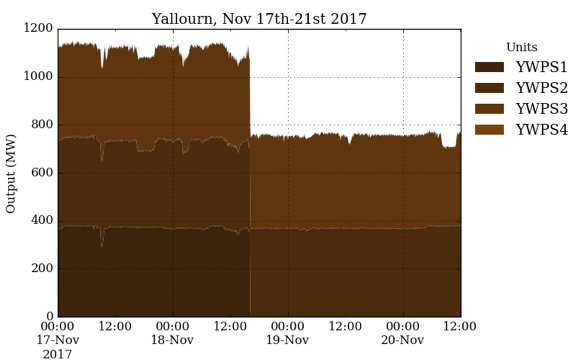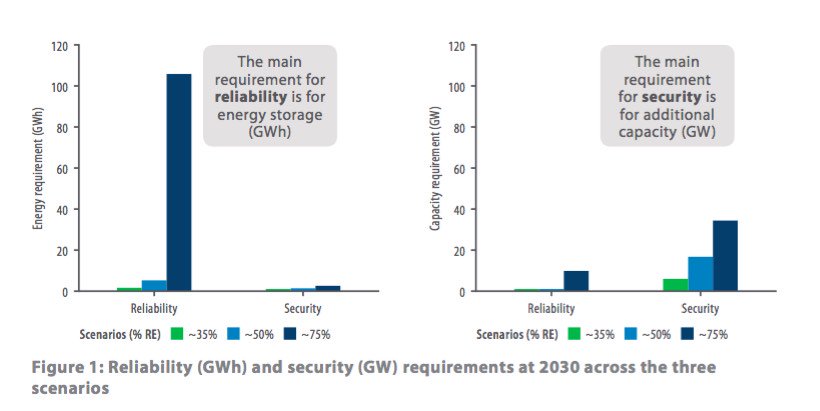Unlike the Dogwood forests that are being cut down in the USA and transported across the Atlantic to provide eco-friendly biofuel for the Drax power plant in the UK.
Genuine question - what is the appropriate units of measurement for a storage facility like a battery? Perhaps a combination of MW and GJ capacities?
Because too many articles just mention MW, and frankly, that is just a flow measurement, and says nothing about how long it can last at that rate…
MWh (or GWh) would be the obvious measures.
Yes Wh is the standard base measure. It’s also used as the standard measure for airline battery carriage restrictions.
Another coal unit falls over, leaving Victoria power supply at risk
By Sophie Vorrath on 20 November 2017
The fragility of Australia’s National Energy Market was highlighted again over the weekend, when unit one of Victoria’s Yallourn coal-fired power plant tripped on Saturday afternoon.
The unscheduled outage took nearly 400MW of generation capacity out of the mix and leaves the state a total 940MW short, with 560MW of capacity still missing from AGL Energy’s Loy Yang A plant, which tripped unexpectedly in October.

The combination of the coal power outages has prompted the market operator to issue a Forecast Lack Of Reserve Level 1 (LOR1) in the state for Tuesday and Wednesday – AEMO’s first step towards warning of a supply shortage – with temperatures forecast to reach 32°C in the state and stay there for most of the week.
LOR1 are not considered a threat to supplies – that doesn’t happen until an LOR3 – but it is unusual for this time of year.
The events underline that the biggest risk to energy supplies this summer are not variable renewable energy generation, but the failure of country’s ageing fossil fuel generators in the mid-summer heat.
Considering we are technically still in Spring, the current situation does not bode well.
AEMO is still yet to be advised on when AGL’s Loy Yang A generator will be back in the mix.
The unit went offline unexpectedly two days before a planned 40-day unit maintenance outage, after it experienced a unit trip due to a generator fault. There are fears that the problem with the generator could run deep.
http://reneweconomy.com.au/another-coal-unit-falls-over-leaving-victoria-power-supply-at-risk-10440/
New Finkel report finds no need to panic about energy storage
By Giles Parkinson on 20 November 2017
Print Friendly
finekl storage two
A new report into energy storage commissioned by chief scientist Alan Finkel highlights the enormous opportunities for storage in Australia, but underlines how little is actually needed over the short to medium term, even at relatively high levels of wind and solar.
The report, The role of Energy Storage in Australia’s Future Energy Supply Mix, funded by Finkel’s office and the Australian Council of Learned Academies (ACOLA), says the required investment in energy security and reliability over the next five-10 years will be minimal (see graph above), even if wind and solar deployment moves far beyond levels contemplated by the Energy Security Board.
The contrast with the ESB modelling – and the attempts by Coalition parties at state and federal level to dismiss high levels of renewable energy as “reckless” – could not be more pronounced.
While the ESB, in arguing for a National Energy Guarantee, speaks of the system threats and urgency to act with a level of “variable” renewables accounting for between 18 and 24 per cent of total generation, this new report says surprisingly little storage may be needed with 35 per cent to 50 per cent wind and solar.
Even in the 50 per cent variable renewable energy scenario – more than double that contemplated at the high end by the ESB – the new report suggests enough battery storage may be available “behind the meter,” households and businesses, to meet the storage needs.
“The modelling provides reassurance that both reliability and security requirements may be met with readily available technologies,” it says.
“Nationally and regionally, the electricity system can reach penetrations of renewable energy close to 50 per cent without significant requirements for energy reliability storage.
“Reliability problems, such as those that recently occurred in South Australia and New South Wales, can be responded to quickly and effectively with appropriate storage.”
In one of the most detailed reports into energy storage, the authors point to the huge potential of battery and energy storage in Australia – both in core mineral resources, manufacturing of battery storage, R&D, deployment, and even renewable hydrogen.
At the same time, the report also warns that Australia needs to develop a recycling strategy for battery storage, and also needs to take into account other social aspects, such as the origins of lithium and cobalt.
But the most striking part of the report is the apparent contrast to the “doomsday” scenarios about renewable energy peddled by the Coalition, and the fossil fuel industry, and reflected in some of the assumption in the proposed National Energy Guarantee.
Yes, the report says, sensible policies are needed to provide a market signal, and the opportunities are boundless. But it does not suggest that wind and solar farms should be penalised for not having storage, or should be made to appear or act like coal-fired power stations.
Indeed, it says the total storage requirement for Australia to meet even a 50 per cent share of variable renewable energy – wind and solar – would be a fraction of the annual spend required of the grid.
This graph illustrates the cost of meeting security and reliability needs for 50 per cent wind and solar – just $10.7 billion in batteries alone. And most of these could be installed behind the meter.
“These numbers are not so huge that we have to go gasp, at least compared to what we are spending anyway on networks,” lead author Professor Bruce Godfrey said.
In fact, spending on storage could actually defray the required spending on poles and wires – possibilities that are beginning to emerge with the creation of micro-grids, and support for new solar investments to help ageing grids cope with rising peak demand.
Pointedly, the study models levels of “variable”renewable energy – wind and solar” that are far higher than that contemplated by the ESB in its argument for an “urgent” reliability option.
The new study’s “low renewable” share – 35 per cent – is twice the amount of wind and solar modeled by the ESB for 2030, at just 18-24 per cent, and yet it sees little need for a lot of added storage.
The study’s medium renewables scenario aims at 50 per cent share of variable renewbles by 2030, while its “high” share models 75 per cent wind and solar penetration.
It even contemplates what is needed for a 100 per cent renewable energy in South Australia – a scenario that looks increasingly possible given the huge range of projects in the pipeline, many with storage of some sort, including pumped hydro, solar thermal, and batteries.
The underlying principle is that for up to 50 per cent renewable share, not that much storage is needed – although this increases rapidly as the share of variable renewables goes beyond that level.
“At an aggregated national level5, Australia can reach penetrations of 50 per cent renewable energy without a significant requirement for storage to support energy reliability,” it says.
In this sense it fits in with the scenarios painted by the CSIRO and Energy Networks Australia in their energy transformation roadmap last year, but the contrast with the assumptions made by the ESB is stark.
“Energy storage is both a technically feasible and an economically viable approach to responding to Australia’s energy security and reliability needs to 2030, even with a high renewables generation scenario,” it says.
It models storage on two services: system security, which is the fast acting response to network faults; and reliability, which is providing enough energy when it is needed.
“In the LOW RE and MID RE scenarios – 35 per cent wind and solar and 50 per cent wind and solar – consumer storage would theoretically be sufficient to provide the entire energy reliability requirement,” it says, although the challenge here might be in “aggregating” these resources.
“The reliability requirement in these two scenarios is small, respectively requiring 1.5 and 5.0 GWh in total, and could be managed by demand responses, such as load shedding.
“The reliability requirement in the HIGH RE scenario is significant with 105GWh and it is hard to imagine how this could be met other than by utility-scale bulk energy storage.”
It suggests that battery storage provides a cost-competitive option for “security” needs, and while pumped hydro provides the cheapest option for bulk storage for reliability (despite its long lead time), it is not clear that will be the case by 2030, when the cost of other technology falls.
“Pumped hydro energy storage (PHES) is presently the cheapest way to meet a reliability requirement,” it says. “Projections indicate that the most cost-effective energy storage ptions available in 2030 will be PHES, lithium-ion batteries and zinc bromine batteries.
“These all have similar levelised cost of storage (LCOS), depending on the PHES sites selected and uncertainty in the rate of reduction of battery costs.”
The release of the report is timely, coming as it does in the same week that the ESB is taking its proposals for the NEG to the COAG energy ministers in Hobart.
While the Finkel commissioned report assumes that its “low” renewable penetration will reflect business as usual, the ESB is assuming that wind and solar will be stopped in its tracks – the inference being that the NEG will be the mechanism to do that.
Added to that the ESB’s modelling of deliberately high technology costs for wind and solar, and its assumption that emission reduction efforts will stop in 2030, then there is no surprise that the idea is being treated with great suspicion by many in the industry.
Professor Godfrey says there is a legitimate role for governments to ensure that the right policy settings are enacted to drive growth in energy storage.
“Hopefully, it will be a well thought through plan,” Godfrey told RenewEconomy, and not using storage to penalise renewables, “but to recognise we are going to have more and more renewables – so let’s get on to thinking more about the future.”
That means framing policies with a view to encouraging innovation, investment and the establishment of new high technology industries, the growth of existing high technology industries and increased or new energy exports.
“A proactive approach will provide the opportunity for Australia to lead and facilitate re-skilling of work forces and the creation of jobs across all levels of the value chain from mining and manufacturing through to consumer spending,” the report says.
Well, this is a dilemma. Who do I find more trustworthy on the subject of climate change and power generation? Scientists, or politicians?
Well I majored in political science so you can have a bob on me each way. We’re completely ■■■■■■
Thanks. Glad I’ve won you over.
It’s your compelling, well reasoned and researched arguments.
It’s nice to be getting this recognition finally.
Kleenex moment
Surely not.
Oh…you mean crying?
Hmmm…
I hope the scientists didn’t create this graphic…
Tesla delivered on the 100 day promise, now SA should have more reliable supply than vic 
Remember when Abbott said there is no way to store renewable. When was that like 3 years ago
This is fundamentally the issue with the old school right luddites, and especially the few around here when they talk down renewable tech.
They completely underestimate the rate of growth and improvement in efficacy and scale.
As soon as Silicon Valley got interested in renewable enegy it was all over. It was only a matter of months before we would see these big leaps in advancements.
I guess all the doco’s on this sort of thing haven’t found their way to Betamax yet.
Lol

